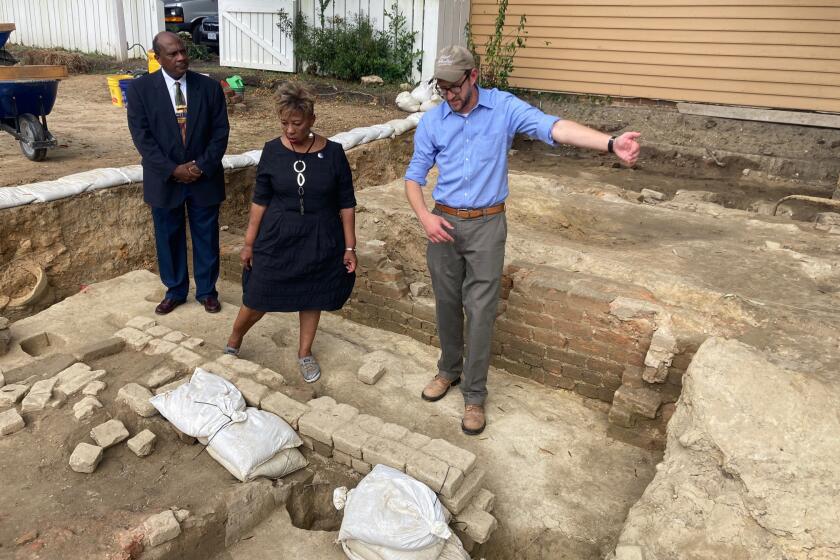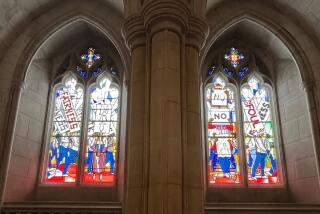Jesus with dark skin? An old stained-glass window in New England stirs up questions

- Share via
WARREN, R.I. — A nearly 150-year-old stained-glass church window that depicts a dark-skinned Jesus Christ interacting with women in New Testament scenes has stirred up questions about race, Rhode Island’s role in the slave trade and the place of women in 19th century New England society.
For the record:
2:37 p.m. May 19, 2023A previous version of this story stated that Hadley Arnold teaches at Woodbury University in Burbank. She is the co-founder of a Los Angeles-based climate tech startup.
The window was rediscovered by Hadley Arnold, co-founder of a Los Angeles-based climate tech startup called DiviningLAB, when she and her family bought the long-closed St. Mark’s Episcopal Church in Warren, R.I., to convert the building into their home.
An expert on the history of stained-glass art said the window, installed in 1878, is the oldest-known public example she has seen of stained glass in which Christ is depicted as a person of color.
“This window is unique and highly unusual,” said Virginia Raguin, a professor emerita of humanities at the College of the Holy Cross in Worcester, Mass. “I have never seen this iconography for that time.”
The 12-foot-tall, 5-foot-wide window depicts two biblical passages in which women, also depicted with dark skin, appear as equals with Christ. One shows Jesus in conversation with Martha and Mary, the sisters of Lazarus, from the Gospel of Luke. The other shows Jesus speaking to a Samaritan woman at the well, from the Gospel of John.
The window made by the Henry E. Sharp studio in New York had largely been forgotten until a few years ago, when Arnold — who grew up in Rhode Island — and her family bought the 4,000-square-foot Greek Revival church building, which opened in 1830 and closed in 2010.
A toy maker raises interesting theological questions with his series of African Bible figures. Some historians take issue with their authenticity, while others laud them for breaking down stereotypes.
When four stained-glass windows were removed in 2020 to be replaced with clear glass, Arnold took a closer look. It was a cold winter’s day with the sunlight shining at just the right angle, and she was stunned by what she saw in one of them: The human figures had dark skin.
“The skin tones were nothing like the white Christ you usually see,” Arnold said.
The window has now been scrutinized by scholars, historians and experts trying to determine the motivations of the artist, the church and the woman who commissioned the window in memory of her two aunts, both of whom married into families that had been involved in the slave trade.
“Is this repudiation? Is this congratulations? Is this a secret sign?” said Arnold.
Months after a fire destroyed Victory Baptist Church, its pastor wrestles with what it means to be a Black church in a Latino neighborhood.
Raguin and other experts confirmed that the skin tones — in black and brown paint on milky white glass that was fired in an oven to set the image — were original and deliberate. The piece shows some signs of aging but remains in very good condition, she said.
But does it depict a Black Jesus? Arnold doesn’t feel comfortable using that term, preferring to say that it depicts Christ as a person of color, probably Middle Eastern, which she says would make sense, given where the Galilean Jewish preacher, whom Christians regard as the Messiah, was from.
Others think it’s open to interpretation.
“To me, being of African American and Native American heritage, I think that it could represent both people,” said Linda A’Vant-Deishinni, the former executive director of the Rhode Island Black Heritage Society. She now runs the Roman Catholic Diocese of Providence’s St. Martin de Porres Center, which provides services to older residents.
A Black family’s Bible ended up in the Smithsonian and helped a California family fill out its genealogy. It’s on display in the National Museum of African American History and Culture.
“The first time I saw it, it just kind of just blew me away,” she said.
Victoria Johnson, a retired educator who was the first Black woman to be named principal of a Rhode Island high school, thinks the figures in the glass are most certainly Black.
“When I see it, I see Black,” she said. “It was created in an era when, at a white church in the North, the only people of color they knew were Black.”
Warren’s economy had been based on the building and outfitting of ships, some used in the slave trade, according to the town history. And although there are records of enslaved people in town before the Civil War, the racial makeup of St. Mark’s was probably mostly white, if not completely so.
Start your day right
Sign up for Essential California for the L.A. Times biggest news, features and recommendations in your inbox six days a week.
You may occasionally receive promotional content from the Los Angeles Times.
The window was commissioned by a woman named Mary P. Carr, apparently in honor of her late aunts, whose names appear on the glass, Arnold said. Mrs. H. Gibbs and Mrs. R.B. DeWolf were sisters, and both married into families involved in the slave trade. The DeWolf family made a fortune as one of the nation’s leading slave-trading families; Gibbs married a sea captain who worked for the DeWolfs.
Both women had been listed as donors to the American Colonization Society, founded to support the migration of freed slaves to Liberia in Africa. The controversial effort was overwhelmingly rejected by Black people in America, leading many former supporters to become abolitionists instead. DeWolf also left money in her will to found another church in accord with egalitarian principles, according to the research.
Another clue is the timing, Arnold said. The window was commissioned at a critical juncture in U.S. history when supporters of Republican Rutherford B. Hayes and their Southern Democratic opponents agreed to settle the 1876 presidential election with what is known as the Compromise of 1877, which essentially ended Reconstruction-era efforts to grant and protect the legal rights of formerly enslaved Black people.
What was Carr trying to say about Gibbs’ and DeWolf’s links to slavery?
Archaeologists in Williamsburg, Va., have begun excavating three suspected graves at the original site of one of the nation’s oldest Black churches.
“We don’t know, but it would appear that she is honoring people of conscience, however imperfect their actions or their effectiveness may have been,” Arnold said. “I don’t think it would be there otherwise.”
The window also is remarkable because it shows Christ interacting with women as equals, Raguin said: “Both stories were selected to profile equality.”
For now, the window remains propped upright in a wooden frame where pews once stood. College classes have come to see it, and on one recent spring afternoon there was a visit from a diverse group of eighth-graders from the Nativity School in Worcester, a Jesuit boys’ school.
The boys learned about the window’s history and significance from Raguin.
Keenan Anderson, one of three people killed in police custody so far in 2023, was a distant cousin of Patrisse Cullors, a co-founder of the Black Lives Matter Global Network.
“When I first brought this up to them in religion class, it was the first time the kids had ever heard of something like this, and they were genuinely curious as to what that was all about, why it mattered, why it existed,” religion teacher Bryan Montenegro said. “I thought that it would be very valuable to come and see it, and be so close to it, and really feel the diversity and inclusion that was so different for that time.”
Arnold hopes to find a museum, college or other institution that can preserve and display the window for academic study and public appreciation.
“I think this belongs in the public trust,” she said. “I don’t believe that it was ever intended to be a privately owned object.”
More to Read
Sign up for Essential California
The most important California stories and recommendations in your inbox every morning.
You may occasionally receive promotional content from the Los Angeles Times.

















